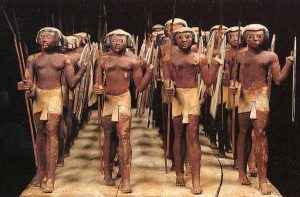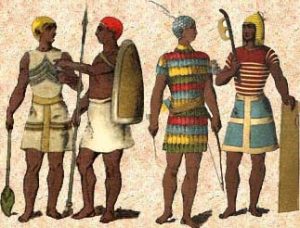The Egyptian civilization was an ancient civilization concentrated along the lower reaches of the Nile River in the North Eastern Africa. This great civilization began around 3150 BC with the political unification of Upper and Lower Egypt under the first Pharaoh and then it continued to thrive over the next three millennia. The history of ancient Egypt Armies is divided into three main stabilised kingdoms: The Old Kingdom from c.2686-2160 BC, the Middle Kingdom from c.2055-1650 BC and the New Kingdom from c.1550-1069 BC and were separated by two unstable intermediate periods.

History of Ancient Egypt Armies
Ancient Egypt was unified under one government for most parts of its history, and thus their main military concern was to keep away enemies from invading their nation.The arid plains and deserts that surrounded Egypt were inhabited by nomadic tribes who occasionally tried to either raid or settle in the fertile Nile river valley. The presence of the great expanses of the desert formed a barrier that protected the river valley and it was almost impossible for massive armies to cross the desert. But the Egyptians built fortresses and outposts in the Eastern Desert, along with the borders east and west of the Nile Delta, and also in Nubia to the south. Most of the Egyptian cities lacked city walls and other defenses.
The Ancient Egypt Armies in the Old and Middle Kingdom were very basic as it consisted of the conscripted peasants and artisans. These people would then fight under the flag of the Pharaoh. Specific military units were used by the early Egyptian army. It was by the Middle Kingdom that while differentiated military hierarchy came in the picture.
It was around 1600 BC, the period when the Egyptians finally defeated the Hyksos and major advance in weapons technology and warfare began. A permanent force was required to be garrisoned abroad for the conquests of foreign territories, like Nubia. Frequent encounters with the nearby powerful Eastern kingdoms like Hittites, the Mitanni, and later the Assyrians and Babylonians, made it necessary for the Egyptians to conduct their military campaigns far from home.
The introduction of horse and chariot into Egypt caused changes in the role of the military in Egyptian society. And it was during the New Kingdom that the Egyptian military changed from volunteer troops to an organization of professional soldiers. The Egyptian military had three major branches: the infantry, the chariotry, and the navy.
Ancient Egypt Infantry
 Infantry troops in ancient Egypt were partly voluntary and partly drafted. Foreigners were also incorporated into the army. Nubian Medjay entered Egyptian armies as mercenaries during the unstable First Intermediate Period and formed some of the best archery units. During the Second Intermediate Period, they were famous for their missions against the Hyksos people, who had made themselves lords of Lower Egypt, under Kamose. In the Middle and early New Kingdoms, Asiatic Maryanne troops were used, whereas the Sherden, the “Na’arn” and the Libyans, were used in the late New Kingdom (c.1292-1075 BC) i.e, in the Ramesses Period.
Infantry troops in ancient Egypt were partly voluntary and partly drafted. Foreigners were also incorporated into the army. Nubian Medjay entered Egyptian armies as mercenaries during the unstable First Intermediate Period and formed some of the best archery units. During the Second Intermediate Period, they were famous for their missions against the Hyksos people, who had made themselves lords of Lower Egypt, under Kamose. In the Middle and early New Kingdoms, Asiatic Maryanne troops were used, whereas the Sherden, the “Na’arn” and the Libyans, were used in the late New Kingdom (c.1292-1075 BC) i.e, in the Ramesses Period.
Ancient Egypt Chariotry

Ancient Egypt Chariotry was inspired from armies of Western Asia and was formally introduced as a division of the army at the end of the Second Intermediate Period (c.1650-1550 BC). By the time of the New Kingdom, it became the backbone of the Egyptian army. Chariots were pulled by two horses and manned by two charioteers where one was a driver who carried a shield, and the other was a man with a bow or javelin. These charioteers were drawn from the upper classes in Egypt. Chariots had infantry support were generally used as a mobile platform from which projectile weapons were used.
Ancient Egyptian Navy

The Egyptian military was mainly aquatic before the New Kingdom. Navy was supposed to be an integral part of the Egyptian army. Though more often than not, it was little more than a means for getting land troops to places where they were needed. However, by the later intermediate period, the navy used complicated naval maneuvers like Kamose’s campaign against the Hyksos in the harbor of Avaris (c.1555-1550 BC). The navy had become highly sophisticated by then.
Egyptian squadrons composed of speedy “keftiu/ kebentiu” from Byblos and Egyptian transports.These squadrons patrolled the eastern Mediterranean. High ranks were composed of the elite middle class. The Egyptian navy had a decisive advantage due to the deployment of archers and the fact that Egyptian ships could both be sailed and rowed. Despite the inferiority of the vessels themselves, the limitation of quite sizable carrying up to two hundred and fifty soldiers at times, the navy was in a good position.
It was after the end of the New Kingdom that Egypt lost its role of maritime superpower. The Greeks and the Phoenicians became the main players in the Mediterranean. Also, the continental powers like the Persians used these sea-faring nations to impose their control on the seas. In an attempt to preserve Egypt’s independence, Queen Cleopatra VII the last of the Ptolemies joined forces with the Roman Marc Anthony. But her fleet was defeated at Actium, which as a result spelled out the end of Pharaonic Egypt.